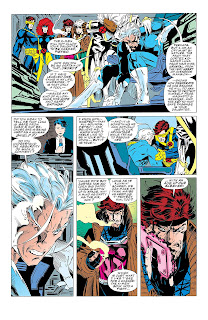Onslaught’s herald has arrived and he is determined to test the might of the X-Men. He kidnaps three of the X-Men’s strongest members – Storm, Cyclops, Wolverine, and Iceman – and forces them to battle against him. With no help from their allies against this monstrous foe, the X-Men must overcome seemingly impossible odds to defeat him. Meanwhile, the Beast is forced into a game of cat-and-mouse with his counterpart from an alternate reality and Archangel fights to save Psylocke’s life as she lays near-death after her encounter with Sabretooth.
X-Men: The Road to Onslaught Volume 3 collects Uncanny X-Men#329-332,Archangel #1, X-Men/Brood#1-2, X-Men Unlimited#10, X-Men #50-52, Wolverine#101, and Xavier Institute Alumni Yearbook. It features writing by Scott Lobdell, Jeph Loeb, Mark Waid, Larry Hama, and more. The art includes work by Bryan Hitch, Andy Kubert, Joe Madureira, and more.
Of the three volumes Marvel collected under the banner of The Road to Onslaught, this one is the weakest. The quality of the issues varies and very little of the stories included actually serve as a prelude to the Onslaught saga. This volume begins with a two-parter where Archangel and Wolverine team-up with Doctor Strange in order to seek a mystical solution to saving Psylocke’s life. It’s one of the better stories in this collection and features some fantastic artwork by Joe Madureira. Having Doctor Strange as a guest star also provides a nice change of pace as it gives the X-Men someone different to interact with. X-Men: Brood, a limited series by John Ostrander and Bryan Hitch, is another highlight. The art is expressive and the storyline itself has a nice weight to it. It also happens to give Jean Grey and Iceman an opportunity to show off their abilities, which I always appreciate. The narrative itself takes the X-Men to a small town where a woman has unexpectedly become a Brood queen and has been turning others in her town into her spawn. This has drawn the attention of another faction of Brood, which has been sent to the town to destroy her and her offspring. The X-Men get caught in the conflict and task themselves with finding a way to cure the woman of her affliction. It’s admittedly a little predictable, but it’s enjoyable. The main gripe here is that it has nothing to do with Onslaught and comes across as rather tangential in the grand scheme of things.
Oddly enough, the material that does connect to Onslaught ends up being some of the least interesting work included here. One of the main arcs includes the Beast from the 616 universe being replaced by his Age of Apocalypse counterpart. It begins in X-Men Unlimited #10 and carries into the main X-books as a subplot. The AoA Beast learns all he can about our Beast and then leads him into a trap in order to hide him away while he takes his place amongst the X-Men. He does so in order to escape the notice of Mr. Sinister. Overall, it’s an odd storyline that feels random and unnecessary. The AoA Beast isn’t an especially captivating villain and it takes a lot to actually believe that he could replace our Beast without being noticed by the X-Men, especially since he does some things that would be suspicious. The other major Onslaught-related storyline is the X-Men’s face-off with Post, Onslaught’s herald. Storm, Cyclops, Iceman, and Wolverine are spirited away to an unknown location and are forced to fight Post. He’s a big and powerful enemy for them, which means that most of the issue is spent with the X-Men in battle. The action-oriented narrative is quite nice, but it’s not as spectacular as it could be. It’s suggested that Storm’s powers are somewhat hampered, but even still she’s not utilized like she could be. Perhaps the best thing about this issue isn’t the comic itself, but rather the one that succeeds it. Iceman is left injured after the conflict and he opts to confront Emma Frost, as she was previously able to control his powers in a way that he’s been unable to. It’s a really fantastic character-focused one-off issue and it really gives us insight into Iceman’s character.
At its core, X-Men: The Road to Onslaught Volume 3 is just a collection of mediocre storylines that don’t benefit from being collected in a rather lengthy trade paperback. Some issues are better than others, largely due to the fact that the creative teams are not consistent throughout. Arguably, the issues written by Scott Lobdell are the strongest. They’re more engaging and have the right balance of action and character development. It also helps that he’s also teamed with the best artists in this collection – like Joe Madureira and Bryan Hitch. Conversely, the issues written by Mark Waid are the least entertaining. These are the ones more focused on the Beast/Dark Beast subplot. Overall, X-Men: The Road to Onslaught Volume 3 isn’t worth its cover price. My recommendation is to merely purchase the Uncanny X-Men issues digitally (or physically if you can find them) since they’re the best of the bunch, plus maybe the Brood limited series by Ostrander and Hitch.
RATING: C-













